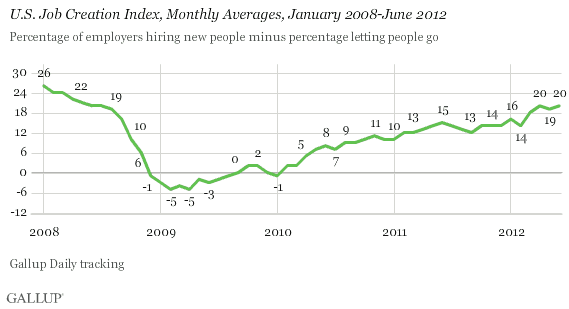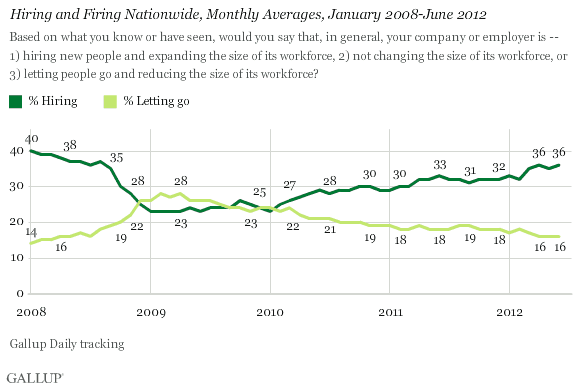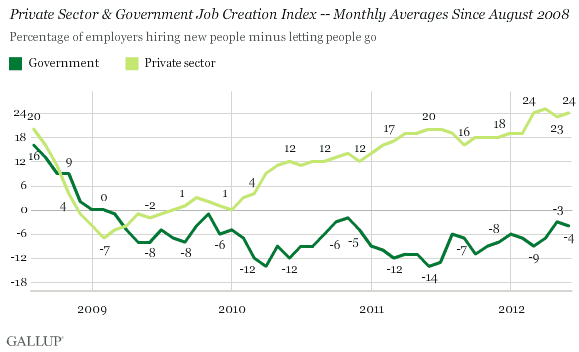PRINCETON, NJ -- U.S. workers reported essentially no change in net hiring at their workplaces in June, with the Gallup Job Creation Index averaging +20 for the month, similar to the +19 recorded in May and identical to the +20 in April. The index continues to hold at levels that are the most positive since mid-2008.

The Job Creation Index in June reflects 36% of U.S. adult workers saying their employers are hiring and expanding the size of their workforces, and 16% saying their employers are letting workers go and reducing the size of their workforces. Both components of the index have also been steady since April.

The June results are based on Gallup telephone interviews conducted throughout the month with a nationwide random sample of nearly 17,000 employed Americans. The index -- not seasonally adjusted -- provides an ongoing summary of U.S. workplace hiring conditions as reported by employees.
Midwest Continues to Edge Out the South in Net Hiring
Regionally, net hiring is strongest in the Midwest (at +24), as it was for most of the prior 13 months, from May 2011 through May 2012. The South is close behind at +22, followed by the East and the West. From January 2008 through April 2011, the South generally led in net hiring, followed by the East and Midwest, with the West coming in last.

Private-Sector Employment Holds at Improved Level
Similar to May, Gallup's Job Creation Index averaged +24 in June among private-sector workers, compared with a score of -4 among government employees.
The private-sector employment picture is much improved after a long, slow recovery, in comparison to its four-year low of -7 recorded in February 2009. It also exceeds the hiring levels seen in August 2008, just prior to the onset of the Wall Street financial crisis.
By contrast, the index has been negative among government workers since March 2009, far below the +16 recorded in August 2008.

Bottom Line
The next-best thing to growth in the labor market is stability at an improved level, and that's where things appear to have stood in June. Gallup's Job Creation Index of +20 for the month reflects the encouraging finding that roughly twice as many workers report their employers are hiring rather than letting people go. While similar to the figures from the prior two months, it is steady and approaching the highest level seen in the 4 ½ years Gallup has tracked U.S. job creation.
Workers in the Midwest and South continue to report better hiring conditions than do those elsewhere in the country, particularly in the West. Hiring conditions have improved in both government and the private sector over the past year, but on a longer-term basis, hiring is up much more in the private sector -- potentially a more sustainable route to economic recovery than if the pattern were reversed.
Gallup.com reports results from these indexes in daily, weekly, and monthly averages and in Gallup.com stories. Complete trend data are always available to view and export in the following charts:
Daily: Employment, Economic Confidence, Job Creation, Consumer Spending
Weekly: Employment, Economic Confidence, Job Creation, Consumer Spending
Read more about Gallup's economic measures.
View our economic release schedule.
Survey Methods
Results are based on telephone interviews conducted as part of Gallup Daily tracking June 1-30, 2012, with a random sample of 16,871 adults, aged 18 and older, employed full or part time, living in all 50 U.S. states and the District of Columbia.
For results based on the total sample of employed adults, one can say with 95% confidence that the maximum margin of sampling error is ±1 percentage point.
Interviews are conducted with respondents on landline telephones and cellular phones, with interviews conducted in Spanish for respondents who are primarily Spanish-speaking. Each sample includes a minimum quota of 400 cell phone respondents and 600 landline respondents per 1,000 national adults, with additional minimum quotas among landline respondents by region. Landline telephone numbers are chosen at random among listed telephone numbers. Cell phone numbers are selected using random-digit-dial methods. Landline respondents are chosen at random within each household on the basis of which member had the most recent birthday.
Samples are weighted by gender, age, race, Hispanic ethnicity, education, region, adults in the household, and phone status (cell phone only/landline only/both, cell phone mostly, and having an unlisted landline number). Demographic weighting targets are based on the March 2011 Current Population Survey figures for the aged 18 and older non-institutionalized population living in U.S. telephone households. All reported margins of sampling error include the computed design effects for weighting and sample design.
In addition to sampling error, question wording and practical difficulties in conducting surveys can introduce error or bias into the findings of public opinion polls.
For more details on Gallup's polling methodology, visit www.gallup.com.
